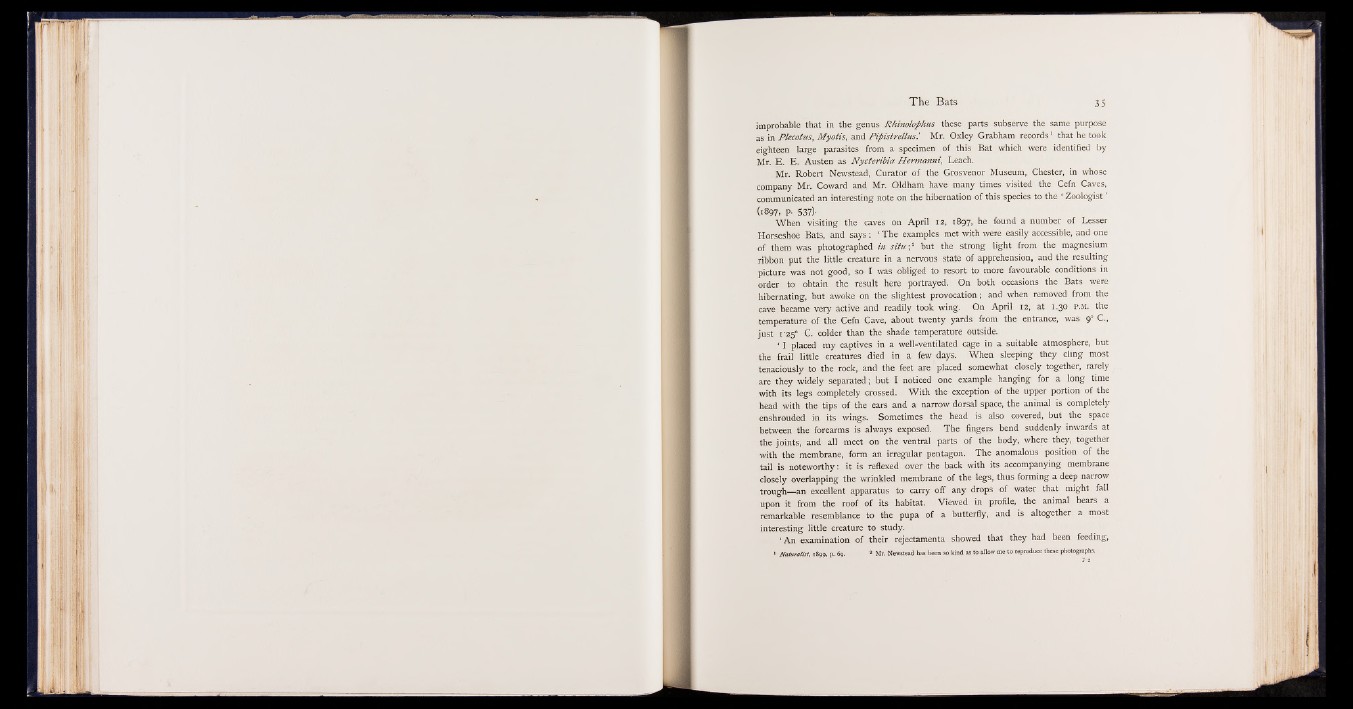
improbable that in the genus Rhinolophus these parts subserve the same purpose
as in Plecotus, Myotis, and Pipistrellus.’ Mr. Oxley Grabham records1 that he took
eighteen large parasites from a specimen of this Bat which were identified by
Mr. E. E. Austen as Nycteribia Hermanni, Leach.
Mr. Robert Newstead, Curator of the Grosvenor Museum, Chester, in whose
company Mr. Coward and. Mr. Oldham have many times visited the Cefn Caves,
communicated an interesting note on the hibernation of this species to the ‘ Zoologist ’
(1897* P- 537)-
When visiting the caves on April 12, 1897, he found a number of Lesser
Horseshoe Bats, and says: ‘ The examples met with were easily accessible, and one
of them was photographed in s itu ;2 but the strong light from the magnesium
ribbon put the little creature in a nervous state of apprehension, and the resulting
picture was not good, so I was obliged to resort to more favourable conditions in
order to obtain the result here portrayed. On both occasions the Bats were
hibernating, but awoke on the slightest provocation ; and when removed from the
cave became very active and readily took wing. On April 12, at 1.30 p-m. the
temperature of the Cefn Cave, about twenty yards from the entrance, was 90 C.,
just 1-25° C. colder than the shade temperature outside.
‘ I placed my captives in a well-ventilated cage in a suitable atmosphere, but
the frail little creatures died in a few days. When sleeping they cling most
tenaciously to the rock, and the feet are placed somewhat closely together, rarely
are they widely separated; but I noticed one example hanging for a long time
with its legs completely crossed. With the exception of the upper portion of the
head with the tips of the ears and a narrow dorsal space, the animal is completely
enshrouded in its wings. Sometimes the head is also covered, but the space
between the forearms is always exposed. The fingers bend suddenly inwards at
the joints, and all meet on the ventral parts of the body, where they, together
with the membrane, form an irregular pentagon. The anomalous position of the
tail is noteworthy: it is reflexed over the back with its accompanying membrane
closely overlapping the wrinkled membrane of the legs, thus forming a deep narrow
trough— an excellent apparatus to carry off any drops of water that might fall
upon it from the roof of its habitat. Viewed in profile, the animal bears a
remarkable resemblance to the pupa of a butterfly, and is altogether a most
interesting little creature to study.
‘ An examination of their rejectamenta showed that they had been feeding,
1 Naturalist, 1899, p. 69. * Mr. Newstead has been so kind as to allow me to reproduce these photographs.